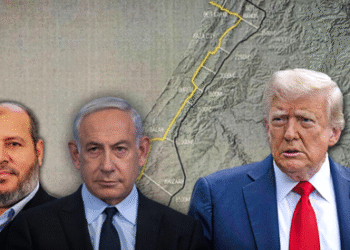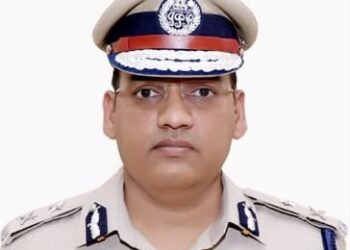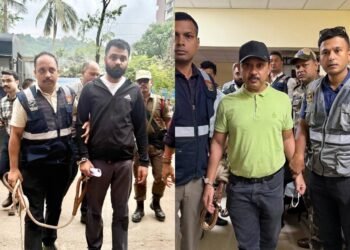NOTE: This is the second installment in a three-part series highlighting the everyday challenges faced by residents of Manipur’s hill district of Churachandpur. In the opening piece, we explored the menace of rising prices and how it has burdened local communities. In this second part, we turn our focus to the state of healthcare in the hills—where inadequate infrastructure and limited access continue to put countless lives at risk. We will expand our lens to cover each hill district before returning to Imphal, the state capital, to examine how it too has suffered in the wake of ethnic clashes and restrictions on free movement. EDITOR
BY Navin Upadhyay
OTE: This is the second installment in a three-part series highlighting the everyday challenges faced by residents of Manipur’s hill district of Churachandpur. In the opening piece, we explored the menace of rising prices and how it has burdened local communities. In this second part, we turn our focus to the state of healthcare in the hills—where inadequate infrastructure and limited access continue to put countless lives at risk. We will expand our lens to cover each hill district before returning to Imphal, the state capital, to examine how it too has suffered in the wake of ethnic clashes and restrictions on free movement. EDITOR
BY Navin Upadhyay
The late Mangboi Lhungdim was more than just a name; he was a vital voice, a soul who infused the lives of his people with poetry. A gifted poet, lyricist, and composer, Mangboi was known for his profound and evocative words, intertwined with deeply moving melodies. His voice resonated with cultural pride, a spirit of resistance, and a deep spiritual yearning—themes that often explored love, loss, the beauty of nature, and the enduring pain experienced by his community.
Tragically, Mangboi’s death was not due to natural causes. He became a casualty of a systemic failure, a stark illustration of the critical absence of advanced medical care in Churachandpur.
During an ethinic clash on August 30, 2023 unrest, Mangboi was struck by shrapnel from shelling or a bomb blast. These fragments pierced his skull, leading to severe head trauma and critical intracranial bleeding—a condition demanding immediate and specialized neurosurgical intervention. However, in Churachandpur, such critical care was simply unavailable.
Reaching the state capital, Imphal, proved impossible due to widespread blockades and ongoing violent clashes. With no viable local options, Mangboi was desperately transported to Guwahati, the nearest city equipped with a trauma center. This arduous 18-hour journey snaked through the mountainous terrain via Aizawl, Mizoram. He fought valiantly for his life on those winding roads, but just three agonizing hours short of reaching Guwahati, his injuries overwhelmed his fragile hold on life. He died on August 3 within the confines of the ambulance.
Mangboi’s untimely death transcends the realm of personal tragedy. It stands as a stark and painful symptom of the chronic underdevelopment plaguing the healthcare sector across remote tribal regions like Churachandpur. A brilliant mind, one with the potential to inspire generations through his art and perspective, was extinguished not because his injuries were inherently untreatable, but because the necessary treatment was geographically and politically out of reach.
How many more people like Mangboi must perish before:
- A fully equipped trauma care center is established within Churachandpur?
- A qualified neurosurgeon is permanently appointed to the district hospital?
- Basic yet critical diagnostic tools such as CT and MRI scans are made available at affordable rates for the impoverished communities?
- Roads are rendered safer for emergency transport, and the crucial option of emergency airlifts becomes a tangible reality?
Mangboi succumbed to this neglect, but for Thangboi, a village grocer, life has become a harrowing existence arguably worse than death. He lost his beloved wife due to the very same absence of advanced healthcare. One ordinary evening, she was gripped by severe chest pain. Their home was situated nearly 30 kilometers from the district hospital. The local primary health center, marked by peeling paint and rusted beds, had no doctor on duty that day. There was no ECG machine, no oxygen supply—only an overwhelmed nurse who could only whisper the desperate instruction: “Take her to the city.”
ALSO READ: Black-Market Fuel and Unsafe Roads Choke Life in Manipur’s Hills (Part-1)
But an ambulance was nowhere to be found. By the time Thangboi managed to secure a private vehicle and reach the main road, his wife had already breathed her last. Later, as he sat by her fresh grave beneath the shade of a plum tree, Thangboi found himself unable to cry. He had grown accustomed to absence—the absence of doctors, the absence of essential medicine, the hollow echo of broken government promises. What truly shattered him was the agonizing knowledge that her death was not an inevitable fate, but a direct consequence of systemic failure.
(I’ve had no firsthand interaction with Thangboi, and his story was narrated to me by someone who knew both him and his wife.)
Key Healthcare Gaps in Churachandpur
Churachandpur faces several critical healthcare challenges, beginning with the complete absence of cancer treatment facilities. There is no oncology center—public or private—in the district. As a result, patients must travel long distances to cities like Imphal or Guwahati, often at great financial and physical cost. Many are forced to forgo treatment entirely, leading to avoidable deaths. Contributing factors include the lack of a dedicated oncology department, essential diagnostic tools like PET/CT scans, and trained oncologists and oncology nurses.
The district also lacks a fully equipped trauma and emergency care system. There is no functional trauma center capable of handling critical cases, and this leads to fatal delays in treating accident victims or those injured in violent incidents. The absence of a dedicated ICU, trauma surgeons, 24/7 anesthesiologists, and properly equipped ambulances compounds this issue.
Neurological emergencies are similarly underserved. There are no practicing neurosurgeons or neurologists in the district, leaving patients with severe head injuries and neurological conditions vulnerable. The district lacks immediate access to vital diagnostic tools like CT and MRI scans, and there are no emergency neuro-care protocols or staff trained in the triage and stabilization of such cases.
Viral load testing is another major gap. The district has no PCR or GeneXpert machines, preventing proper monitoring of chronic viral conditions such as Hepatitis B, Hepatitis C, and HIV. The absence of a virology lab, trained virologists, and appropriate biosafety infrastructure further hampers patient care.
Other general deficiencies include extremely limited radiology services, with MRI available only through an expensive private provider and CT scans in short supply. Cardiology services are minimal, lacking 24/7 ECG and cardiac monitoring. Pediatrics suffers from the absence of a Neonatal Intensive Care Unit (NICU), contributing to high infant mortality. The sole dialysis unit at the district hospital is overwhelmed, and no public alternative exists. Mental health support is virtually non-existent, despite rising cases of PTSD and substance addiction, especially in light of the ongoing conflict and limited access to care.
ALSO READ: No U-Turn: Centre Unmoved by Demands to End PR In Manipur
“There are numerous instances where patients suffering from severe head injuries are simply given painkillers and left to the uncertain mercy of God,” recounts Dr. Chinkholal Thangsing, the Director of Touch of Hope Healthcare, painting a grim picture of the local reality. “Transporting them to Guwahati involves a treacherous 14-hour road journey followed by a flight. The survival rate in such critical situations is devastatingly low. All we can do is offer hope and prayers.”
Highly Interesting Read: New RFK Assassination Records Could Challenge Official Story
Dr. Thangsing further elaborates on the dire situation: “There are no specialty facilities whatsoever—no dedicated cardiac care, no liver or kidney treatment centers. Cancer patients bear the heaviest burden. We lack even basic chemotherapy facilities. The nearest option is Guwahati, but how many individuals in this economically disadvantaged region can realistically afford the exorbitant costs of travel, accommodation, and prolonged treatment there? Tragically, most are forced to give up, succumbing to the relentless progression of the disease.”
Until a mere three months ago, MRI facilities were entirely absent within the district. While a private provider has recently established one, the prohibitive charges render this crucial diagnostic tool inaccessible to the vast majority of the low-income population.
“It’s an utterly tragic situation,” laments Sam Haokip, a concerned local resident, echoing the sentiments of many. “The district hospital is forced to shoulder the immense burden of serving the entire region. A medical college and hospital were inaugurated nearly two years ago, offering a glimmer of hope, but the eruption of ethnic clashes severely disrupted their functioning. The faculty remains woefully inadequate, and the infrastructure is grossly insufficient to meet the overwhelming needs.”
For persons battling renal failure, dialysis services are available at the district hospital, but even this essential facility is critically overwhelmed, operating far beyond its intended capacity.
“Following the outbreak of ethnic clashes, most non-Meitei doctors—primarily general physicians—returned to Churachandpur. As a result, basic healthcare services are somewhat available,” explains Dr. Thangsing. “However, when it comes to specialized care, which is often the critical difference between life and death, we have virtually nothing.”
READ: Special Story: Timber Smuggling in Manipur: Assam Rifles Crackdown Exposes Deep-Rooted Illicit Trade
Another physician, speaking on condition of anonymity, highlighted yet another critical crisis: the chronic shortage of essential medicines. “Our medicine supplies primarily come from Aizawl. This often leads to significant delays in the supply chain. During such periods, we face a grave crisis. If a specific, urgently needed medication is not locally available, we are simply unable to prescribe it, leaving patients in dire straits.”
Adding to the already precarious situation is the complete absence of diagnostic testing facilities for viral loads in prevalent diseases such as Hepatitis B, Hepatitis C, and HIV. “We simply do not have the necessary equipment or infrastructure for these crucial tests. Samples must be sent all the way to Aizawl or Guwahati, a process that introduces unacceptable delays. It’s truly heartbreaking,” the physician added with palpable frustration.
Churachandpur is undeniably grappling with a profound healthcare crisis. The critical absence of trauma care facilities, oncology services, and essential diagnostic infrastructure is directly causing unnecessary deaths and inflicting unbearable suffering on its residents, particularly those from impoverished backgrounds.
ALSO READ: No U-Turn: Centre Unmoved by Demands to End PR In Manipur
“The healthcare catastrophe in Churachandpur is not an isolated incident. The same tragic reality unfolds across all the hill regions, consistently ignored by successive state governments,” asserted Astor Lunkim, a local resident and a prominent Kuki voice on social media.
“Those outside Manipur cannot even imagine the desperate plight in the hills,” he added. “Here, people are simply left to die because they are denied access to treatment.”
Victims of Apathy:
The district tragically trapped between the ravages of conflict and the crippling effects of neglect—continues to suffer the consequences of broken systems, forgotten promises, and the irreplaceable loss of human lives. While hundreds perished in the initial frenzy of violence that gripped the state, countless more have since succumbed to the silent killer of absent healthcare, the lack of essential medicine and equipment, and the dire shortage of advanced diagnostic laboratories. As I conclude this account, my thoughts return to Mangboi Lhungdim—the poet whose voice now echoes in the silence of his absence. Will his poignant poetry remain merely a lament, a testament to loss? Or will it rise as a rallying cry, compelling his people to transform grief into action?
While researching Mangboi’s life and work, one stanza from his song “I Gam Hilou Ham” (translated as “Is this not our land?” struck me with haunting clarity. It felt less like a verse and more like a call—an urgent plea to his people to stand up for the lives threatened by the same injustice that claimed his own.
(English Translation)
Rise, my brethren, let us gather
It’s time to stand together as one
In unity, we’ll face the impending wave
And confront this darkest hour together
Isn’t this our land that nurtures us?
Why must we wander as if in exile?
Must we be turned into strangers in our own home?
Can you bear this injustice, my dear people?













